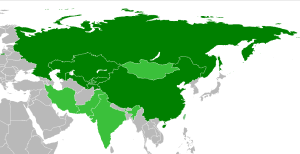The Tsar Bomba, officially known as RDS-220 or Big Ivan to its Soviet creators, is the most powerful nuclear device ever detonated by man. The first and only one of its kind was tested on October 30, 1961 at 11:32am. It was a 100 megaton bomb design but the uranium fusion stage tamper of the tertiary and secondary stages was replaced with lead, thus reducing the yield by 50% by disposing with the fast fissioning of the uranium tamper by the fusion neutrons. What that means is, the change in materials led to a much smaller explosion than originally planned but also had the added bonus of reducing the expected fallout by 97%. The effect of this bomb at full power would have been catastrophic on the Earth, increasing the world’s total fission fallout since the invention of the atom bomb by 25%. Do you understand? The fallout from one detonation of the Tsar Bomba would have been equivelant to 1/4 of all fallout from hundreds of atomic detonations up until that time.
The bomb was tested at Novaya Zemlya Island in the Russian Arctic Circle. It was airdropped and detonated at around 4,000 meters, being visible from1,000 kilometers away despite overcast weather. Even at the great height at which it exploded, the fireball reached down to the Earth and rose almost to the height at which is was deployed at 10,500 meters. The blast pressure below the burst point was 6 times greater than the Hiroshima bomb at 300 PSI. One cameraman recalled:
The clouds beneath the aircraft and in the distance were lit up by the powerful flash. The sea of light spread under the hatch and even clouds began to glow and became transparent. At that moment, our aircraft emerged from between two cloud layers and down below in the gap a huge bright orange ball was emerging. The ball was powerful and arrogant like Jupiter. Slowly and silently it crept upwards…. Having broken through the thick layer of clouds it kept growing. It seemed to suck the whole earth into it. The spectacle was fantastic, unreal, supernatural.
Shock waves were felt over 700 kilometers away, windows were broken at distances in excess of 900 kilometers, All buildings within 55 kilometers were destroyed and all wooden buildings within hundreds of kilometers were wiped out while stone or concrete buildings sustained massive damage. Radio communications were disrupted for almost an hour and atmospheric disturbance created by the blast orbited the planet an estimated three times. The mushroom cloud rose 64 kilometers into the atmosphere. The explosion shook the entire planet with seismic equipment on the other side of the Earth registering a seismic magnitude of 5.0 to 5.25. Ground zero had been glassed at the center of impact and eye-witnesses described the entire area as looking like a “skating rink” because the ground was swept clean and flat due to the blast wave and ultra high heat. All planes involved in the operation had been coated with a special reflective paint due to the calculation that the 50 megaton blast would be capable of causing 3rd degree burns at distances of 100+ kilometers. The effective damage radius of the weapon extended out to a 1,000 kilometer radius.
The Soviet Union was quickly condemned in the United Nations and the Western allies jumped back into the nuclear arms race. Thankfully, this monster never made it into the production line. The device’s size, weight, as well as it’s frightening destructive capabilities were deemed too extreme for use in a real conflict.







